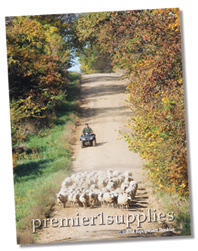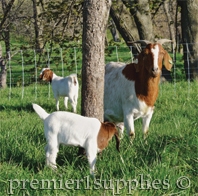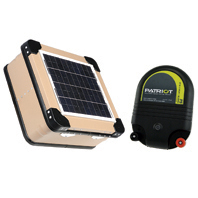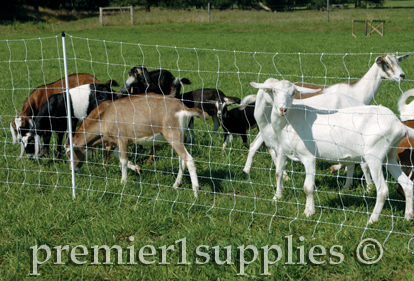2014 EQUIPMENT BOOKLET
 New! 2014 Equipment Booklet
New! 2014 Equipment Booklet
It includes, along with our standard products, the following new items:
| • |
Goat Bells: Wide choice of attractive designs that differ in tone, cost and size. |
| • |
Barn Bells: High-quality brass cast bells with ornamental black metal hardware. Make your house or barn distinctive. |
| • |
Qwik Tags and Applicator: Small, low-cost, temporary one-piece nylon tag for goat kids and lambs. |
| • |
EZ CatchNet: Nifty way to catch kids and lambs that are too small to be caught with a crook. Also works for catching chickens and geese. |
| • |
Cradle: An easy-to-use-and-wash kid and lamb carrier. Plastic ridges securely grip slick newborns. |
| • |
Tooth File: Some does reject newborn kids that have sharp teeth. A quick touch with a file means fewer orphans. |
| • |
Large Braided Halters and Neck Ropes: For use on older animals. Same quality materials and construction as our other braided products. |
Didn't receive Premier's new 2014 "Equipment Booklet" in your mailbox?
If not, request a catalog or you can go to our website to view all of our products.
NETTING USES

Goats are both curious and intelligent. That’s why the only portable fence that stops both adult and baby goats is electrified netting (ElectroStop® 10/42/12 shown above. ElectroStop® Plus also available). Regrettably, animals with horns, like this nanny, are at greater risk of becoming entangled by the horns in netting. To reduce the risk, keep the voltage high and properly train animals to the fence!
Temporary ElectroStop® 10/42/12
| • |
To strip-graze pastures and short-term crops such as turnips and rape. |
| • |
As an interim permanent fence until a proper fence can be built. |
| • |
To enclose rams and buck/billy goats. |
| • |
To keep coyotes, dogs and bears out. |
| • |
To keep domestic dogs in. |
| • |
To graze orchards and vineyards. |
| • |
To make temporary lanes for moving animals from place to place. |
| • |
To make replaceable water gaps. |
| • |
To protect outdoor hay supplies. |
| • |
To graze stockpiled forage on hayfields in late fall and early winter. |
Because it’s so easy to install and remove, many move Premier’s netting weekly—fencing the herd instead of the field.
Need Semi-Permanent and Permanent fencing for goats? Premier offers a wide range of options.
Remember: Free shipping if ordered online and if order exceeds $100. (See details.)
ENERGIZER OPTIONS

Shown above are the Premier PRS 50 and Patriot P5 energizers.
Which unit is right
for you?
The size, in pulse energy output (range from .5 joule to 2 joules), depends almost entirely on the length of the fence and the weed contact that will occur along the fence line.
Contact Premier or call 800-282-6631 to speak with one of our fence consultants to help you determine the best energizer for your needs.
You can also view our energizer comparison charts online or in Premier's fencing catalog for help in choosing an energizer.
Contact Premier or call 800-282-6631 to speak with one of our fence consultants to help you determine the best energizer for your needs.

If it's the end of your fencing season, you'll find our video above on how to properly store your energizer and batteries for winter helpful, with instructions and tips the folks at Premier have learned by experience.
|
 |
 |

Goats are known far and wide for their ability to "test" fences. For us, we found our best option (short of a 10 ft brick wall) to be a well electrified roll of netting (PermaNet™ 10/48/6 shown).
Goats—Inquisitive Creatures
Folks who raise (or have raised) goats know that they are deceptively intelligent creatures. They have an enhanced ability to know when a fence is tired/worn or that the person milking them has absolutely no idea what they're doing. The goats use this knowledge to make themselves nuisances at the most inopportune moments.
How So?
| • |
They breach fences when the roses in the garden are in full bloom or the in-laws are visiting. |
| • |
They kick over the milk bucket for while novices try to milk them. |
To avoid such occurrences, read the articles below and brush up on how to milk a goat and use goats for browsing. Give the goats a job (and treat them well) and possibly they'll act more as eccentric pets rather than pests.
GOAT MILKING BASICS
Proper Hand Milking Procedures
By Rosalie Sinn (for Heifer Project International) and Jennifer Stultz with permission from the Dairy Goat Journal
Learning how to milk a goat by hand involves using the proper equipment and procedures. It also involves a personal love for animals, especially the dairy doe, who so willingly shares her bounty with those who care for her.
Equipment needed to properly milk and care for the milking dairy goat includes the following items: a milking stand (optional), a milk bucket (stainless steel or enamel is best but any deep, clean container can be used), two cups (one for examining the milk prior to full milking, one for teat dip), a filter or strainer or clean cloth for straining the milk, a pan for pasteurization, a container for the milk, cool water to cool the milk rapidly, teat dip (may be two percent iodine or a solution of 50 percent bleach and 50 percent clean water), soap and water, clean clothes.
After making sure all the needed equipment is assembled and clean after having been washed with soap and water and air or sun dried, cover items not in use with a clean cloth.
Place some feed in a bucket or in the feed container attached to the milking stand. Wash your hands.
Bring the goat to the milking location and tie her or put her on the milking stand.
If the goat’s udder is dirty, wash it with soap and water and dry with a clean towel. If the goat’s udder is clean and free of manure and dirt, simply brush away loose hair and/or dirt.
Direct the first milk from each teat into a cup. Examine this milk for any stringy, lumpy milk, or blood in the milk. Do not use the milk if this occurs; it could be an indication of sickness or mastitis. Do milk out the udder and discard the milk, then ask a veterinarian for help/advice.
If the first milk is clear, clean and good, place the milk pail under the goat.
Grasp the teat with thumb and index finger together to trap the milk in the teat. Gently but firmly, bring pressure on the teat with a second finger forcing the milk down further. The third finger does the same and then the little finger.
Massage and gently bump the udder while milking and the doe will let down more milk.
Read More »
EXTENSION NEWS
Grazing and Forages for
Meat Goats
North Carolina State University Extension
Jean-Marie Luginbuhl, Extension Meat Goat Specialist, James T. Green, Jr., Extension Pastures & Forage Systems Specialist, J. Paul Mueller, Extension Pastures & Forage Systems Specialist, Matthew H. Poore, Extension Animal Husbandry Specialist, North Carolina State University 05/07/2004
Forages For Goats
Goats offer an opportunity to more effectively convert pasture nutrients to animal products as milk, meat and fiber which are currently marketable and in demand by a growing segment of the US population. In addition, goats selectively graze unwanted vegetation in pastures and forests, thus providing biological control which will reduce dependence on certain pesticides.
Goats consume only the most nutritious parts of a wide range of grasses, legumes, and browse plants. Browse plants include brambles, shrubs, trees, and vines with woody stems. The quality of feed on offer will depend on many things, but it is usually most directly related to the age or stage of growth at the time of grazing. The nutrient composition for several common feed types found on many farms is shown in
Table 1.
Grazing Behavior
Goats are very active foragers, able to cover a wide area in search of scarce plant materials. Their small mouths and split upper lips enable them to pick small leaves, flowers, fruits and other plant parts, thus choosing only the most nutritious available feed.
The ability to utilize browse species, which often have thorns and an upright growth habit with small leaves tucked among woody stems, is a unique characteristic of the goat compared to heavier, less agile ruminants. Goats have been observed to stand on their hind legs and stretch up to browse tree leaves or throw their bodies against saplings to bring the tops within reach.
The feeding strategy of goats appears to be to select grasses when the protein content and digestibility are high, but to switch to browse when the latter overall nutritive value may be higher. This ability is best utilized under conditions where there is a broad range in the digestibility of the available feeds, giving an advantage to an animal which is able to select highly digestible parts and reject those materials which are low in quality.
Grazing goats have been observed to:
| • |
Select grass over clover. |
| • |
prefer browsing over grazing pastures. |
| • |
prefer foraging on rough and steep land over flat, smooth land. |
| • |
graze along fence lines before grazing the center of a pasture. |
| • |
graze the top of pasture canopy fairly uniformly before grazing close to the soil level. |
Read More »
AGRICULTURAL CASE STUDY
Graze Goats to Get Rid of Plants You Don’t Want
By Leopold Center for Sustainable Agriculture, Iowa State University
Grazing Goats Case Study Key Points Goats:
| • |
eat trees, brush, weeds and other unwanted plants |
| • |
quickly knock down tall weeds and brush when crowded into a small space |
| • |
eat up and high, while cattle eat low and down |
| • |
require good fences |
Steve Smith’s goats would rather eat thistles than grass. “I move them around to any place I have plants I don’t want,” the Marshall County farmer says of his small herd of Nubian goats, “and they’re pretty good at cleaning up tall weeds and brush.” “If you want healthy goats, give them some tree branches,” Smith says. “They’ll eat about any tree at any time of year. Their preferences are woody plants first, then taller broadleafs or forbs, then clover, and grass last.”
While his goats will eat about anything, they do want weeds to be at the right stage of growth, Smith says. “They love musk thistle at the right stage, and Canadian thistles at the bloom stage. They also really like multiflora rose, horseweeds, lambsquarter, ragweed, and burdock.”
Goats do very well on weeds, too. Smith says milk production takes a jump when a doe gets to feast on stinging nettles. “But one ate stinging nettles so long she lost her voice,” Smith laughs.
He says his goats can kill multiflora rose in a season if he’s patient. “The strategy is to move the goats into the weedy or brushy area for a few days, and let them eat all the leaves and small branches off the plants. Then take them out, to let the trees, bushes or weeds recover enough to put new leaves back on, using the plant’s energy to do that. Then you move the goats in again. When you do this several times, you weaken the plant and it will die,” Smith says. “It’s will die over the winter if not during the season.”
Read More »
The case study was prepared for the Grass-Based Livestock Working Group, supported by the Leopold Center for Sustainable Agriculture, www.leopold.iastate.edu. For related case studies, see the working group's web page.
|
|